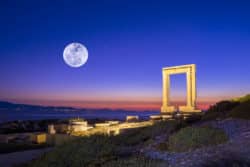About Naxos, Greece
Naxos is the largest of the islands in Cyclades group. The capital and largest town in Naxos is Naxos City (or Chora). The island is well-known for being a source of emery. Emery is a rock rich in corundum. Until modern times, it was the best abrasive available. During the Cycladic civilization, Emery was exported to other islands.
Greek mythology says that young Zeus was raised in a cave on Mt. Zas. “Zas” means Zeus. Homer mentioned Dia, the sacred island “of the goddess.”  The name Dia, which means “divine” or “heavenly,” was given to a number of small, scraggly islands in the Aegean Sea. The name Dia was eventually given to Naxos itself. Two Naxos myths involve giant brothers Otus and Ephialtes. In one of the myths, Artemis bought the abandonment of a siege they had laid against the gods. She did this by offering to live on the island and be Otus’ lover. In another myth, it was the brothers who settled Naxos Island.
The name Dia, which means “divine” or “heavenly,” was given to a number of small, scraggly islands in the Aegean Sea. The name Dia was eventually given to Naxos itself. Two Naxos myths involve giant brothers Otus and Ephialtes. In one of the myths, Artemis bought the abandonment of a siege they had laid against the gods. She did this by offering to live on the island and be Otus’ lover. In another myth, it was the brothers who settled Naxos Island.
Zas Cave, which was inhabited during the Neolithic era, was found to contain items made of stone from Melos and copper objects. The copper objects included a dagger and gold sheet. These items have allowed researchers to determine the status of those who inhabited the cave.
During the Byzantine era, Pope Martin I was detained on the island by Byzantine authorities for almost a year due to holding a synod (an assembly of clergy) that condemned Monothelitism. Monothelitism is a teaching about how humans and divine relate in the person of Jesus. He would be held on the island before being taken to Constantinople to stand trial.
Naxos Island would finally become part of the Greek state in 1832.
Top Attractions in Naxos Island, Greece
Portara – Also known as “The Great Door,” it is a large marble doorway. It was meant to be the largest building in Greece, but construction was interrupted and never restarted. All that remains is the door and three of four columns.
Temple of Demeter – A temple dedicated to Demeter. Built in the 6th century and discovered in 1949. There is a small church next to the temple.
Panagia Drossiani – Built in the 6th or 7th century. This church is found in the town of Moni. Inside is decorated with beautiful wall paintings.
Bazeos Tower – Dates back to the 17th century. Built on the main road from Naxos City to Halka and Filoti to protect residents from pirate attacks.
Potomia – Well-known for its production of fruits. Close to medieval towers and old mills. Located 9 km south of Chora.
Orkos Beach – A secluded, non-organized beach. 10 km south of Chora. Soft sand with surrounding green areas.
Mikri Vigla Beach – The perfect beach choice if you’re into windsurfing. A partly organized beach located 16 km south of Naxos City. Water sports facilities line the beach.
Ancient Aqueduct – The remains of an ancient aqueduct that can be traced throughout the island. Can be viewed in various locations in Naxos including: Barou and Kastro. There is an information center in Flerio.
Mycenaean Tomb – Built in 1300 BC. Was meant to be the resting place of an unknown ruler as the condition of the tomb has deteriorated. Located in Koronida.
Venetian Museum – Located in Chora in the 800- year old home of the Della Rocca family. Stepping into the home is like taking a step back into Venetian times. A guided tour lasts approximately 40 minutes.

